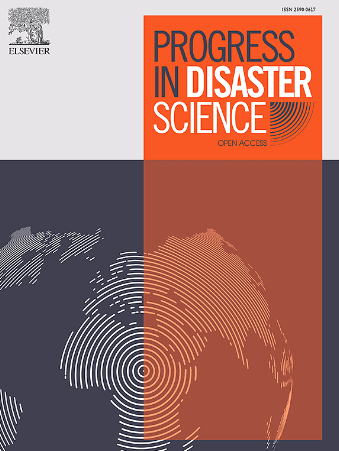探索影响少数民族灾害风险意识的因素:孟加拉国加罗社区案例研究
IF 3.8
Q3 ENVIRONMENTAL SCIENCES
引用次数: 0
摘要
本研究考察了孟加拉国Netrokona地区Garo社区对灾害风险的认知,重点关注社会经济和环境因素。这项研究在兰差地、伦古拉和库拉古拉三个地区进行,调查了365户家庭。数据收集于2024年10月,采用结构化问卷,采用“R”程序进行统计分析。有序逻辑回归模型确定了与灾害风险评级相关的关键因素。调查结果显示,44%的受访者认为他们所在的地区是“高”灾害风险区,与经济脆弱性(73.97%的人每月收入低于1.5万泰铢)和受教育机会有限有关。超过63%的人被迫流离失所,70.68%的人报告家园被淹没,森林砍伐和地下水枯竭等环境恶化加剧了这种情况。社区因素,如地方治理和基础设施,也影响了灾害风险观念,Lengura和Rangchati的居民报告的风险观念较低。职业、收入和以前的灾害经历(包括流离失所)与风险意识的提高密切相关。拥有高架房屋或强大社会支持网络的家庭准备较好,而80.27%的家庭缺乏早期预警系统。该研究强调,需要有针对性地制定灾害管理战略,整合当地知识,增强社区抵御能力。本文章由计算机程序翻译,如有差异,请以英文原文为准。
Exploring factors affecting disaster risk perception in ethnic minority: A case study in Garo community, Bangladesh
This study examines disaster risk perception among the Garo community in Netrokona district, Bangladesh, focusing on socioeconomic and environmental factors. Conducted in three unions- Rangchati, Lengura, and Kullagora- the research surveyed 365 households. Data were collected in October 2024 using a structured questionnaire, and statistical analysis was conducted using the ‘R' program. Ordinal logistic regression models identified key factors associated with disaster risk ratings. Findings reveal that 44 % of respondents perceive their area as a “High” disaster risk zone, associated with economic vulnerabilities (73.97 % earn less than 15,000 BDT/month) and limited access to education. Over 63 % have experienced forced displacement, and 70.68 % reported home inundation, exacerbated by environmental degradation like deforestation and groundwater depletion. Community factors, such as local governance and infrastructure, also shaped disaster risk perceptions, with residents of Lengura and Rangchati reporting lower risk perceptions. Occupation, income, and previous disaster experiences, including displacement, were strongly associated with heightened risk awareness. Households with elevated homes or strong social support networks had better preparedness, while 80.27 % lacked access to early warning systems. The study highlights the need for tailored disaster management strategies that integrate local knowledge and enhance community resilience.
求助全文
通过发布文献求助,成功后即可免费获取论文全文。
去求助
来源期刊

Progress in Disaster Science
Social Sciences-Safety Research
CiteScore
14.60
自引率
3.20%
发文量
51
审稿时长
12 weeks
期刊介绍:
Progress in Disaster Science is a Gold Open Access journal focusing on integrating research and policy in disaster research, and publishes original research papers and invited viewpoint articles on disaster risk reduction; response; emergency management and recovery.
A key part of the Journal's Publication output will see key experts invited to assess and comment on the current trends in disaster research, as well as highlight key papers.
 求助内容:
求助内容: 应助结果提醒方式:
应助结果提醒方式:


